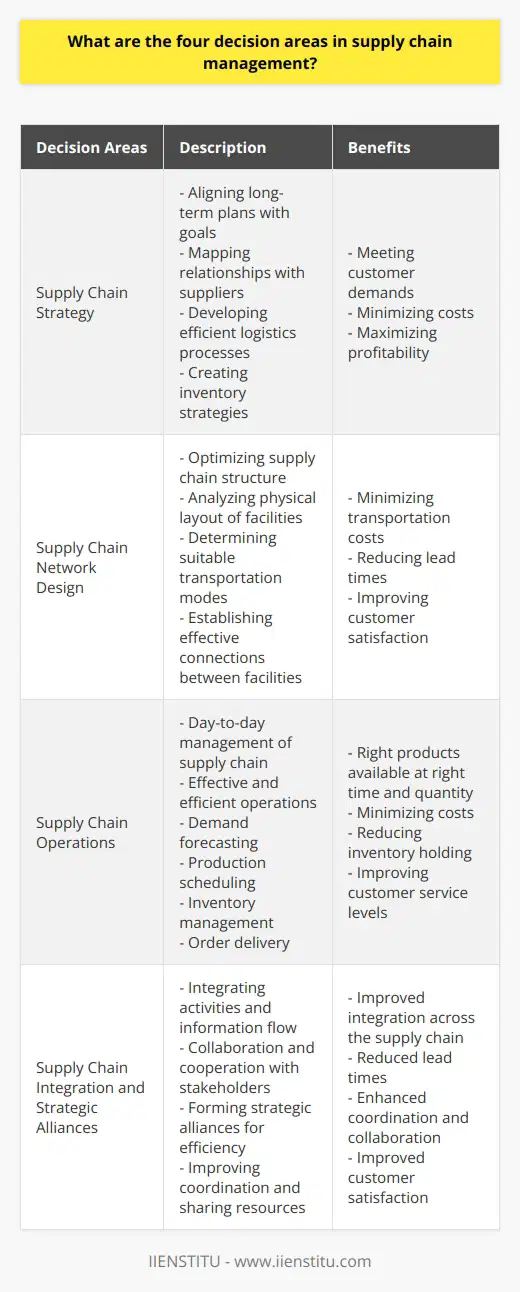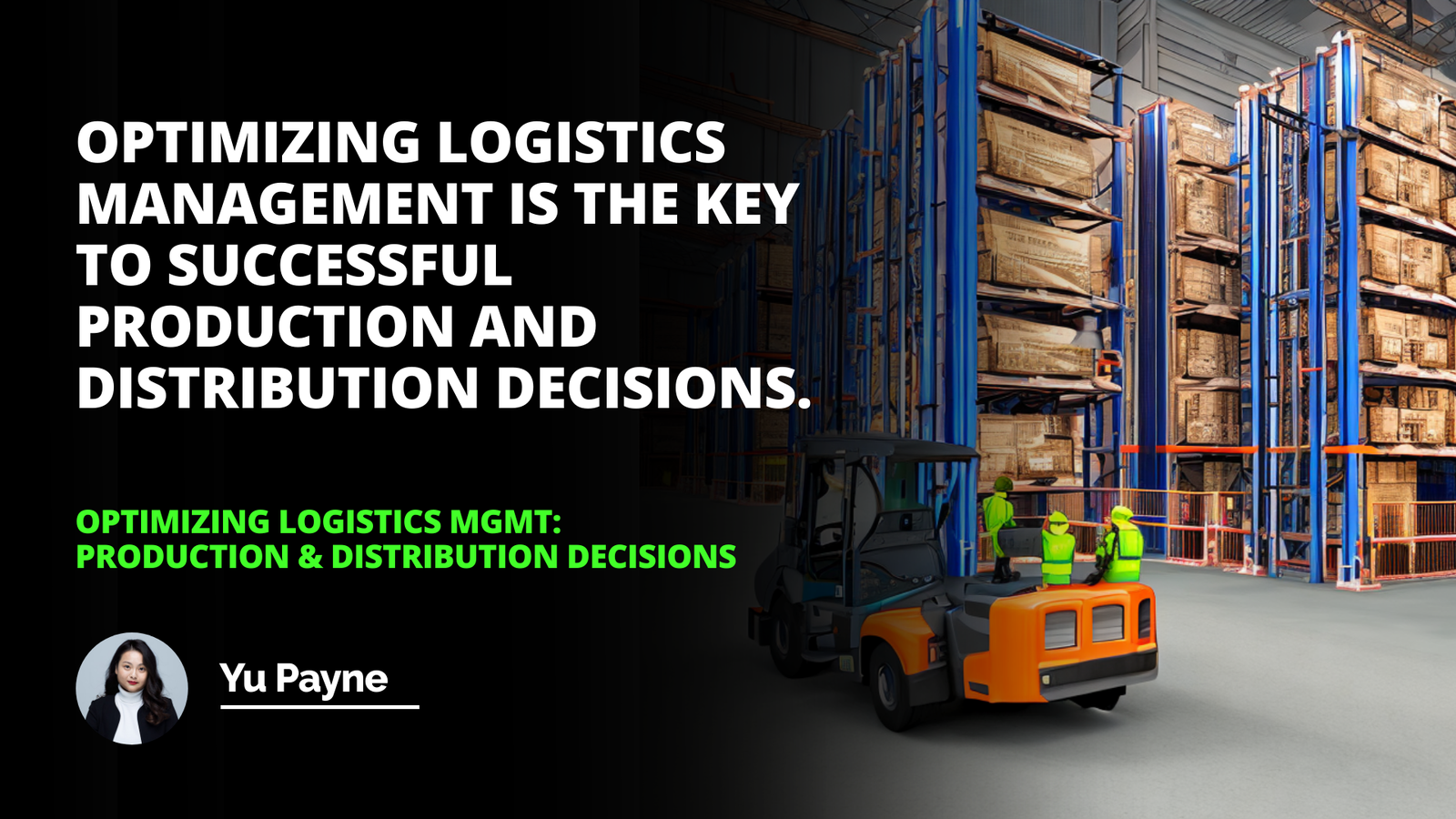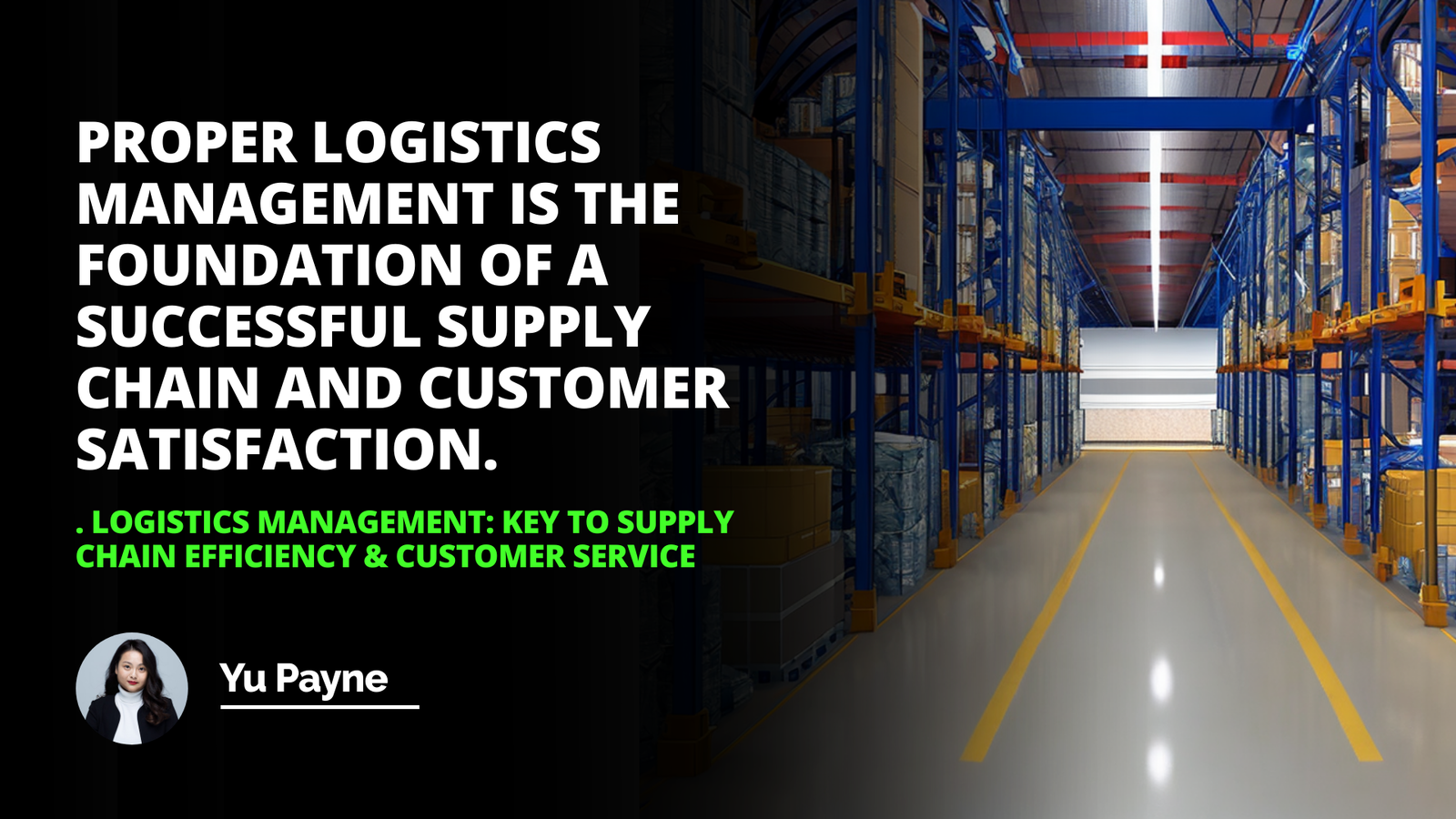
When I first stepped into the world of supply chain management, I had no idea how integral warehousing would become to my daily life. I vividly recall visiting a sprawling warehouse on the outskirts of my hometown—a massive building that seemed to breathe life into the products it housed. The hum of conveyor belts, the beeping of forklifts, and the meticulous organization of goods left an indelible impression on me. It became clear that warehousing wasn't just about storing products; it's about making strategic decisions that could optimize the entire supply chain management process.
Location
Size
Layout
Ownership
The Heartbeat of the Supply Chain: Warehousing
Warehousing is more than just a stopover point for goods; it's the heartbeat of the supply chain. A well-designed warehouse ensures that products flow smoothly from manufacturers to consumers, reducing delays and cutting costs. But achieving this efficiency isn't a matter of chance. It requires careful consideration of several critical factors:
1- Location
2- Size
3- Layout
4- Ownership
Let's delve into each of these areas, drawing from personal experiences, anecdotes, and industry best practices.
Location: Finding the Sweet Spot
Choosing the right location for a warehouse feels a bit like finding the perfect home. You want it to be in a neighborhood that's safe, accessible, and suits your needs. I remember when I was part of a team tasked with selecting a new warehouse location for a mid-sized retail company. We had to consider:
Proximity to Suppliers and Customers: Being close to suppliers reduces inbound shipping costs, while proximity to customers speeds up delivery times.
Digital Transformation İmpact On Supply Chain İnterview Question
Collaborative Logistics Strategies For Supply Chain Efficiency
Access to Transportation Networks: Highways, ports, and railroads are the arteries of logistics. A warehouse near these networks can reduce transit times and costs.
Labor Availability: A location with a skilled workforce ensures the warehouse operates smoothly.
Infrastructure and Utilities: Reliable power, water, and internet services are non-negotiable.
We mapped out various potential locations, weighing factors such as transportation costs and delivery times. In the end, we chose a site near a major highway intersection, which significantly reduced our transportation expenses and improved delivery speed. It was a decision that paid dividends in customer satisfaction and cost savings.
Size Matters: Scaling for Success
Determining the appropriate size for a warehouse is akin to planning for a family. You want enough space to accommodate growth but not so much that you're burdened with unnecessary costs.
When we expanded our operations, we faced the classic dilemma: How big should our new warehouse be? We considered:
1- Current Inventory Levels: Assessing the volume of stock-keeping units (SKUs) we handled.
2- Future Growth Projections: Estimating how our inventory might expand in the next 5-10 years.
3- Equipment and Machinery Needs: Allocating space for forklifts, conveyor systems, and other machinery.
Warehousing location and size define opportunity layout, optimize success and ownership, and enable long-term security.
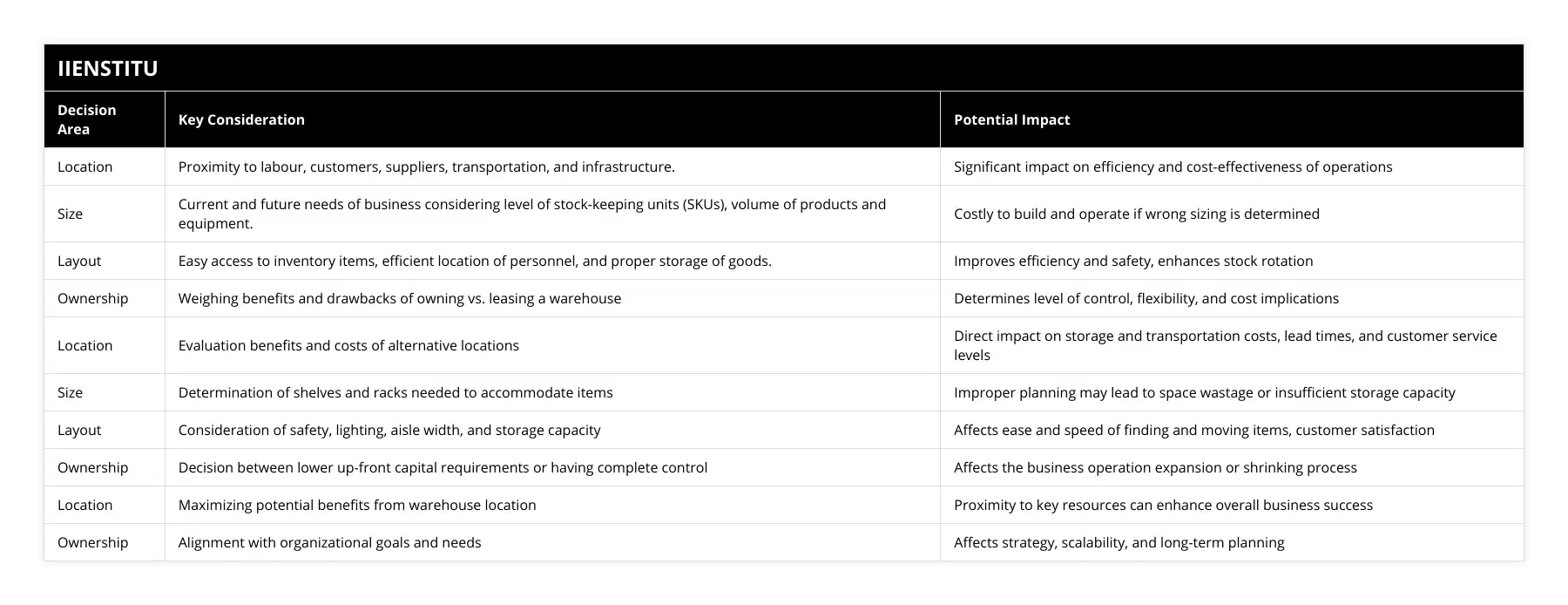
4- Operational Space: Including areas for loading docks, offices, and employee facilities.
We applied a formula from "Warehouse Management: A Complete Guide to Improving Efficiency and Minimizing Costs in the Modern Warehouse" by Gwynne Richards (2014), which helped us calculate our space requirements more accurately. By planning for the future, we avoided the pitfalls of outgrowing our space too quickly.
Italicized insight: It's better to have room to grow than to be cramped from the get-go.
Layout: Designing for Efficiency
A warehouse's layout is like the blueprint of a well-oiled machine. A thoughtful design can improve efficiency, safety, and employee satisfaction. During one project, we faced challenges with bottlenecks in the picking area, leading to delays.
To address this, we implemented the following steps:
Analyzed Workflow Patterns: Tracked how goods moved through the warehouse.
Redesigned Aisle Widths: Adjusted aisle sizes to allow for smoother traffic flow.
Optimized Storage Solutions: Utilized vertical space with higher shelving and installed pallet racking systems.
Implemented Technology: Introduced a warehouse management system (WMS) to coordinate activities.
After these changes, not only did our order fulfillment speed increase by 20%, but our workers also reported a better working environment.
*Bold statement: An efficient layout doesn't just boost productivity; it elevates the entire operation.*
Ownership: To Buy or to Lease?
Deciding whether to own or lease a warehouse is a significant financial decision. Early in my career, I worked with a startup that debated this very topic. The arguments centered around:
Benefits of Owning:
1- Asset Building: Ownership can be a long-term investment.
2- Control Over Customization: Ability to modify the facility to specific needs.
3- Stability: No worries about lease expirations or landlord issues.
Benefits of Leasing:
1- Lower Upfront Costs: Frees up capital for other investments.
2- Flexibility: Easier to relocate if business needs change.
3- Reduced Responsibility: Landlords typically handle major repairs and maintenance.
We ultimately chose to lease, which provided us the flexibility to adapt as the company grew. However, for more established businesses, ownership might offer the security and customization they require.
Underlined takeaway: Each option has its merits; the choice depends on the company's long-term strategy.
Optimizing the Supply Chain: Tips and Strategies
To optimize supply chain management processes, consider the following tips:
1- Conduct Regular Audits: Keep tabs on inventory levels and warehouse efficiency.
2- Invest in Technology: Utilize WMS and automation to streamline operations.
3- Train Staff Thoroughly: Well-trained employees are more efficient and make fewer errors.
4- Embrace Sustainability: Implement eco-friendly practices to reduce costs and appeal to environmentally conscious consumers.
By integrating these strategies, businesses can not only improve their warehousing operations but also enhance the overall supply chain performance.
Conclusion: The Foundation of Success
In the grand scheme of supply chain management, warehousing might seem like just one piece of the puzzle. However, as I've learned through years of experience, it's a foundational element that can make or break a company's efficiency and reputation.
By carefully considering the warehouse's location, sizing it appropriately, designing an efficient layout, and choosing the right ownership model, businesses can gain a competitive edge. These decisions require thoughtful analysis, but the rewards—reduced costs, improved customer satisfaction, and greater operational efficiency—are well worth the effort.
Final thought: Remember, every product that reaches a customer's hands has likely passed through a warehouse. Making that journey as smooth as possible starts with the decisions we make about these critical facilities.
References
Richards, G. (2014). Warehouse Management: A Complete Guide to Improving Efficiency and Minimizing Costs in the Modern Warehouse. Kogan Page Publishers.
Frazelle, E. (2002). World-Class Warehousing and Material Handling. McGraw-Hill.
Ackerman, K. B. (1997). Practical Handbook of Warehousing. Springer Science & Business Media.
Tompkins, J. A., & Smith, J. D. (1998). The Warehouse Management Handbook. Tompkins Press.
Frequently Asked Questions
What should be taken into account when selecting a warehouse location?
When selecting a warehouse location, many factors must be taken into consideration. The first and foremost consideration must be the market potential of the site. A warehouse must be located in an area with access to both the buyers who purchase the product and the suppliers who provide the necessary production resources. The company's needs should also be considered when choosing a suitable location. For example, does the company need more warehouse capabilities, or will a smaller space be sufficient?
In addition to market potential, other aspects must be considered when choosing a warehouse location. For example, it is essential to assess the existing infrastructure in the region, such as transportation routes, electricity and water lines, and the availability of skilled labor. Moreover, the cost of renting or leasing the space is also a determining factor, as it is essential to maintain a profitable business model. Additionally, the warehouse's security must be considered when selecting a location, such as the availability of a security system and personnel, as well as the topography of the surrounding area.
Furthermore, the area must comply with relevant environmental regulations when choosing a warehouse location. This is especially important when dealing with hazardous materials stored or handled in the warehouse. Finally, a factor that must be considered is the potential for growth at the chosen location to ensure the business's sustained success.
In conclusion, it is of utmost importance that multiple factors are considered when selecting a warehouse location for a company. The market potential of the region, existing infrastructure, cost of leasing, security, environmental compliance, and growth potential are all important considerations that must be taken into account to ensure the optimal deployment of a business's resources.

How do you determine the size of the warehouse for a particular project?
Several important factors must be considered when considering the size of the warehouse for a particular project. These include the nature of the products involved, the anticipated storage duration, the storage capacity, the area available for storage, and the ability to manage the storage space.
Firstly, the products that are being stored need to be considered, as this will determine the size of the warehouse required. Different product sizes, weights, and shapes will mean different storage needs. For example, small products like books could require smaller shelf units. In contrast, heavier and bulkier items such as furniture or machinery may require larger warehouse spaces.
The time the products are expected to be stored in the warehouse must also be considered, as this will also impact the warehouse size needed. The duration of storage is determined by the overall production and selling cycles, collecting, storing, and delivery aspects of the project. Longer durations require more warehousing space, while shorter durations require only a smaller warehouse.
The storage capacity of a warehouse and the amount of space available also need to be considered. Generally speaking, the more storage capacity available, the larger the warehouse. Additionally, if the storage space is limited, it will be more important to make the most effective use of it. This may require custom-built shelving and labeling systems and a high degree of organization and optimization.
Finally, the ability to manage the warehouse, mainly at total capacity, is also a critical aspect to consider when determining the size. Effective warehouse management requires strategies and capabilities to locate and move inventory, monitor, replenish, and manage inventory, organize storage, and facilitate efficient operations. In addition, appropriate personnel, technology, processes, and storage assistance are needed to ensure a warehouse runs seamlessly and efficiently.
In conclusion, various factors should be considered when determining the warehouse size for a particular project. These include the nature of the products involved, the anticipated storage duration, the storage capacity, the area available for storage, and the ability to manage the storage space. Appropriate consideration of these critical elements will ensure the right size and capabilities for a successful project.

How can my warehouse layout and ownership be optimized for efficiency?
In today's increasingly competitive business environment, warehousing and logistics play an increasingly important role in a company's success. An efficient warehouse layout and ownership model can ensure that a company operates efficiently and profitably. This article examines various aspects of warehouse layout and ownership that can help improve warehouse efficiency.
Firstly, it is essential to consider the size of a warehouse and the number of goods it can store. Depending on the nature of the business and its operating environment, warehouse size should be determined accordingly. An overly large warehouse may be an inefficient use of space and resources. Still, an adequate size could lead to efficient operations. Therefore, balancing inventory storage needs with warehouse space optimizations is essential.
Secondly, the layout of a warehouse can have a profound effect on its efficiency. It is essential to ensure that space is allocated with maximum efficiency, such that items are stored in the most appropriate areas of the facility. This means that things should be kept near the appropriate access points, reducing the time and effort required to move items around the facility. Furthermore, items should be grouped according to their purpose, which can help optimize the facility's layout. Finally, the design should consider the ease of access by staff and potential customers, as this can further enhance efficiency.
Thirdly, it is critical to consider ownership of the warehouse. This can be divided into two categories: request of the physical facility and its contents. On a physical level, the right of a warehouse can be determined according to several factors, including a company-owned or leased asset, shared ownership models linked to specific activities, or outsourced operations. Each of these models has its advantages and disadvantages. The optimal choice should depend on a range of factors, such as the nature of the business, expected timelines, required storage capacity, and the desired level of control.
In summary, businesses need to consider a range of factors when considering the layout and ownership of their warehouses. These factors can include the size of the warehouse, the design of the facility, and the right of the physical facility and its contents. As a result, businesses can maximize their efficiency and profitability by utilizing an efficient warehouse layout and ownership model.
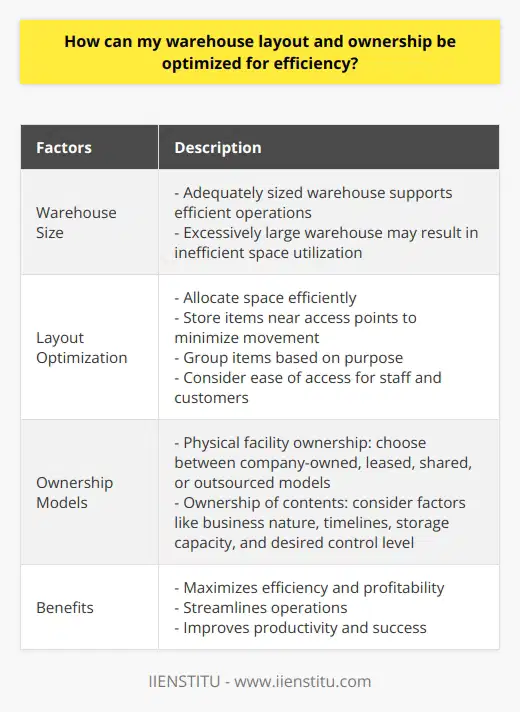
What factors contribute to the decision-making process in determining the size and layout of a warehouse?
Factors Influencing Warehouse Size and Layout
Multiple factors contribute to the decision-making process in determining the optimal size and layout of a warehouse. These factors can be broadly categorized into three main areas: operational requirements, financial considerations, and external influences.
Operational Requirements
A primary criterion in warehouse design is the volume and characteristics of inventory items. A larger variety of products and significant fluctuations in demand patterns necessitate larger storage areas and adaptable layouts. Moreover, warehouse operations, such as order picking and sorting, require specific space allocations, leading to adjustments in overall size and layout.
Financial Considerations
Financial factors play a crucial role in warehouse planning. Cost constraints can limit the size and sophistication of a warehouse, necessitating a trade-off between desired features and budget limitations. Property costs, for example, can sway decision-makers toward smaller, cost-effective spaces or layouts that maximize efficient land use.
External Influences
External factors, such as regulations and location, may also impact warehouse design. Local zoning laws, building codes, or environmental regulations can dictate specific size and layout requirements. Additionally, the warehouse's location relative to customers, suppliers, and transportation infrastructure can influence the optimal design, as proximity can either enhance or constrain logistics efficiency.
In conclusion, determining the size and layout of a warehouse involves a comprehensive assessment of operational needs, financial factors, and external influences. By carefully considering these variables, decision-makers can optimize the warehouse design to support efficient and cost-effective logistics operations.

Which key considerations must be addressed when making significant warehousing decisions?
Key Considerations in Warehousing Decisions
Strategic Location Selection
A crucial consideration in making warehousing decisions is selecting an optimal location that balances transportation costs, customer access, and other logistical factors. An effective location can minimize transportation expenses, expedite delivery times, and streamline distribution channels.
Warehouse Design and Layout
Another key aspect of warehousing decisions is designing the warehouse layout, taking into account storage requirements, space utilization, and material handling systems. An efficient design can enhance inventory management, reduce handling time, and improve order fulfillment.
Inventory Management Techniques
Employing effective inventory management techniques is critical in warehousing decisions, as they determine optimal stock levels, reorder points, and turnover rates. Such techniques may include first-in, first-out methods or just-in-time strategies to minimize holding costs and ensure product availability.
Technology Integration
Integrating technology, such as automation and warehouse management systems, can significantly impact warehousing decisions. Leveraging technology can improve inventory tracking, optimize picking processes, and enhance order accuracy, leading to operational efficiency and cost savings.
Workforce and Training
Considering workforce requirements and employee training is an essential element in warehousing decisions, as skilled and motivated staff can enhance productivity, reduce errors, and contribute to overall operational success. Moreover, investing in continuous employee development can promote a culture of continuous improvement, fostering efficiency and adaptability.
Environmental and Regulatory Compliance
Complying with environmental and regulatory requirements is critical when making warehousing decisions, as noncompliance may result in fines, penalties, and reputational damage that can adversely affect the business. Adopting sustainable practices, such as energy-efficient lighting, waste reduction strategies, and proper hazardous material handling, can demonstrate a company's commitment to sustainability and corporate responsibility.
Financial Analysis
Lastly, conducting a financial analysis of warehousing decisions is essential to evaluate the cost-effectiveness, profitability, and return on investment of various solutions. Thoroughly assessing the financial implications of warehousing options can ensure that strategic decisions align with the organization's budgetary constraints and long-term goals.
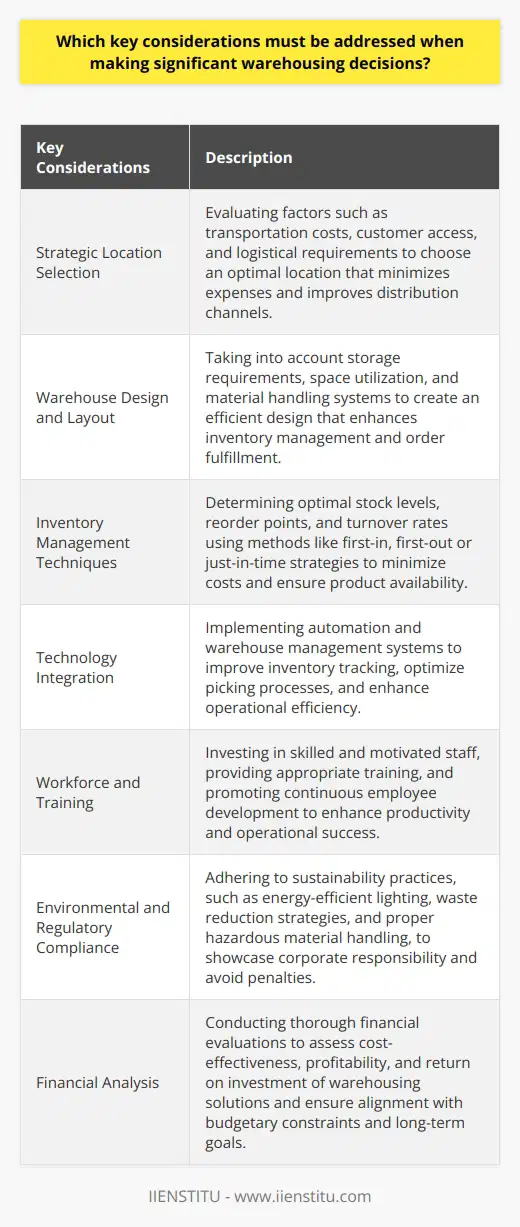
How do warehouse location decisions vary across the three different levels of evaluation?
Warehouse Location Factors
The decision-making process for warehouse location involves various factors across three levels of evaluation: strategic, tactical, and operational. In each level, the scope, timeline, and focus of the decision-making process vary, as discussed below.
Strategic Level
At the strategic level, long-term factors such as market demand, economic conditions, and company growth plans drive warehouse location decisions. This stage typically involves a top-down approach, considering global and regional aspects to identify the optimal locations for serving target markets, reducing transportation costs, and leveraging economies of scale. Key criteria in this level include proximity to customers, supplier networks, transportation infrastructure, and availability of skilled labor.
Tactical Level
The tactical level of the decision-making process deals with medium-term factors, translating the strategic choices into more detailed and location-specific criteria. In this stage, the focus shifts towards selecting the most suitable location within the identified region, based on factors such as local taxation, regulations, real estate availability, and existing facilities. Additionally, companies need to assess the competitive landscape in the chosen area, identifying potential competitors and collaboration opportunities.
Operational Level
Finally, the operational level of warehouse location decisions focuses on short-term, site-specific factors that facilitate day-to-day operations in the chosen location. This phase typically involves a bottom-up analysis to ensure that the location meets specific requirements related to warehouse size, layout, and essential infrastructures such as electricity, water, and internet connection.
Moreover, companies need to consider facility management aspects, including environmental, health, and safety regulations and compliance, as well as the local labor market conditions. These factors contribute to the ease and efficiency of operating a warehouse in the chosen location, ultimately impacting overall logistics performance.
In conclusion, the warehouse location decision-making process comprises a combination of strategic, tactical, and operational factors, each guided by different priorities and timelines. By comprehensively addressing all three levels of evaluation, companies can make informed decisions that align with their long-term objectives, regional requirements, and daily operational needs.
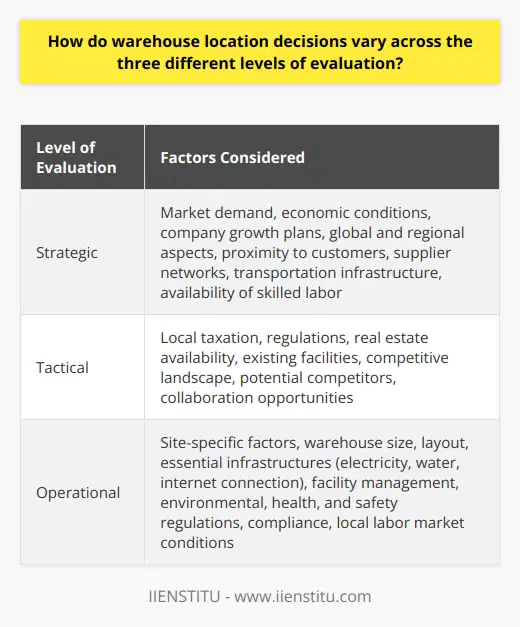
What factors play a critical role in determining the optimal size and layout of a warehouse?
Warehouse Size Considerations
Several factors influence the optimal size and layout of a warehouse. First, determining the storage capacity is essential, taking into account the product's size, shape, and weight. High-density storage systems or multi-level picking structures may be necessary for maximizing the storage space in smaller warehouses. Understanding product rotation and velocity rates can aid in determining the warehouse size needed to minimize handling costs and maintain efficient inventory control.
Layout Efficiency Factors
The warehouse layout plays a significant role in improving operational efficiency. The placement of receiving, storage, and shipping areas affects the overall flow of materials and labor through the facility. Strategically positioning high-velocity items near the shipping areas can reduce travel time for pickers and increase throughput. Additionally, taking into account the accessibility of storage and staging areas for inbound and outbound transportation can reduce congestion, minimize wait times, and improve overall warehouse efficiency.
Material Handling Equipment Integration
Integrating suitable material handling equipment (MHE) into the warehouse design is crucial for productivity improvement. Considering aisle widths, clear heights, and floor load capacities can help identify the optimal layout that will accommodate the specific MHE requirements. Furthermore, analyzing the efficiency of the equipment in relation to the layout can lead to the identification of areas for improvement, leading to both labor and cost savings.
Flexibility for Future Growth
When optimizing warehouse size and layout, it is crucial to consider potential future growth, incorporating flexibility into the design to accommodate the changing needs of a business. This could include provisions for additional storage capacity or integrating modular structures that can be easily reconfigured or expanded. Considering future growth can help ensure that the warehouse remains efficient and functional even as the business expands or experiences seasonal fluctuations in demand.
In conclusion, determining the optimal size and layout of a warehouse is crucial for operational efficiency and success. Key factors to consider include storage capacity, layout efficiency, the integration of appropriate material handling equipment, and flexibility for future growth. By thoroughly examining these critical factors, warehouse managers can ensure that their facility best supports their business's needs.
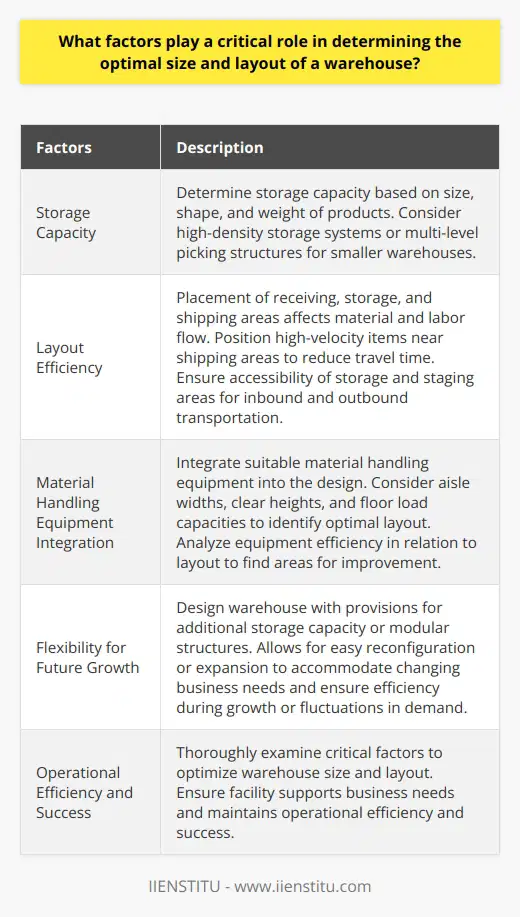
How do major warehousing decisions affect the overall supply chain and inventory management?
Key Factors of Warehousing Decisions
The optimization of warehousing decisions is essential for reducing costs and improving efficiency in the supply chain and inventory management. Major warehousing decisions like site selection, warehouse design, and technology investment have a significant impact on the overall performance of a supply chain.
Site Selection
The location of a warehouse influences transportation costs, delivery time, and accessibility to suppliers and customers. A strategic location is advantageous, as it enables easy access to major transportation routes and reduces the overall transportation expenses. Additionally, warehousing decisions concerning geographic location are influenced by factors such as available land, labor costs, and government regulations, which all affect the profitability of supply chain operations.
Warehouse Design
Designing a warehouse layout that maximizes space utilization and minimizes material handling for efficient storage and retrieval of inventory is crucial. A well-designed warehouse contributes to reducing labor costs, improving operational efficiency, and enhancing inventory management. Implementing an optimized warehouse layout results in better organization and accessibility of inventory, which in turn reduces lead times and enhances customer satisfaction.
Technology Investment
Investing in advanced technology for warehouse operations, such as warehouse management systems (WMS) and automation solutions, increases efficiency and accuracy in inventory management. Technology-driven initiatives can greatly improve order processing times, reduce human errors, and enhance data visibility within the supply chain. Furthermore, the adoption of technologies like the Internet of Things (IoT) and artificial intelligence (AI) automates inventory tracking and monitoring, allowing for better visibility and control of inventory levels.
In conclusion, major warehousing decisions play a vital role in shaping the overall supply chain and inventory management. A strategic focus on site selection, warehouse design, and technology investments leads to lower costs, improved efficiency, and better customer satisfaction. These decisions are critical to the competitiveness of a business and its ability to successfully navigate today's complex supply chain landscape.
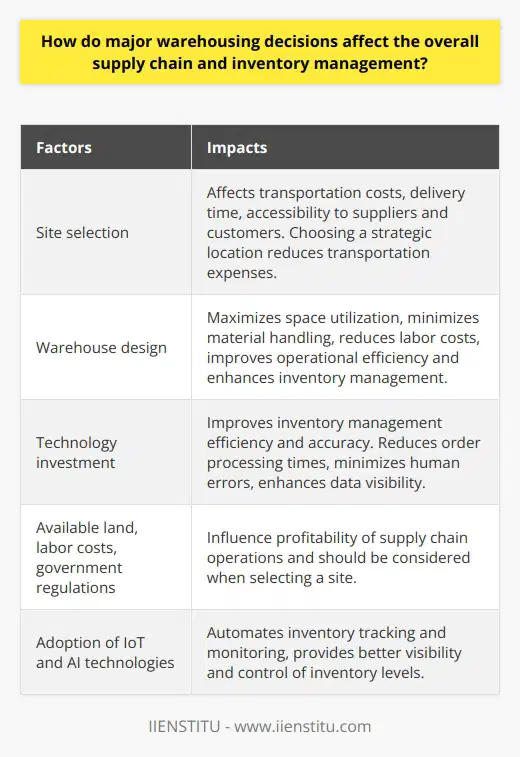
Can you elaborate on the three levels of warehouse location decisions and the factors that influence these decisions?
Warehouse Location Decisions
Three primary levels of warehouse location decisions include the strategic, tactical, and operational levels. Each level is influenced by various factors that affect the warehouse's optimal location, ultimately impacting supply chain efficiency and overall organizational performance.
Strategic Level
The strategic level of decision-making focuses on the long-term selection of warehouse locations, aimed at supporting the organization's broader objectives. Key factors affecting these decisions are the business's strategic goals, market coverage, competition, and the overall supply chain design. For example, e-commerce companies may choose warehouses closer to urban markets to ensure faster delivery times and a competitive advantage over other businesses.
Tactical Level
At the tactical level, warehouse location decisions involve evaluating choices within a specific region to optimize cost, service, and time-based factors. Crucial aspects include transportation costs, proximity to suppliers and customers, warehouse capacity requirements, and government policies such as tax incentives or trade barriers. For instance, an organization might choose a location near a major road or rail network to minimize transport costs and ensure timely deliveries.
Operational Level
Finally, the operational level focuses on short-term decisions that target the efficient and effective management of warehouse operations. Factors such as labor availability, infrastructure quality, property costs, and availability of supporting services, such as customs and inspections, play a critical role in the decision-making process. Warehouses located in areas with skilled labor, good infrastructure, and affordable property may provide significant operational advantages.
In conclusion, warehouse location decisions involve evaluating various factors at the strategic, tactical, and operational levels. By carefully considering these aspects, organizations can optimize their supply chain and improve overall performance. A well-thought-out warehouse location strategy can lead to cost savings, efficiency improvements, and a competitive advantage that benefits all stakeholders in the supply chain.
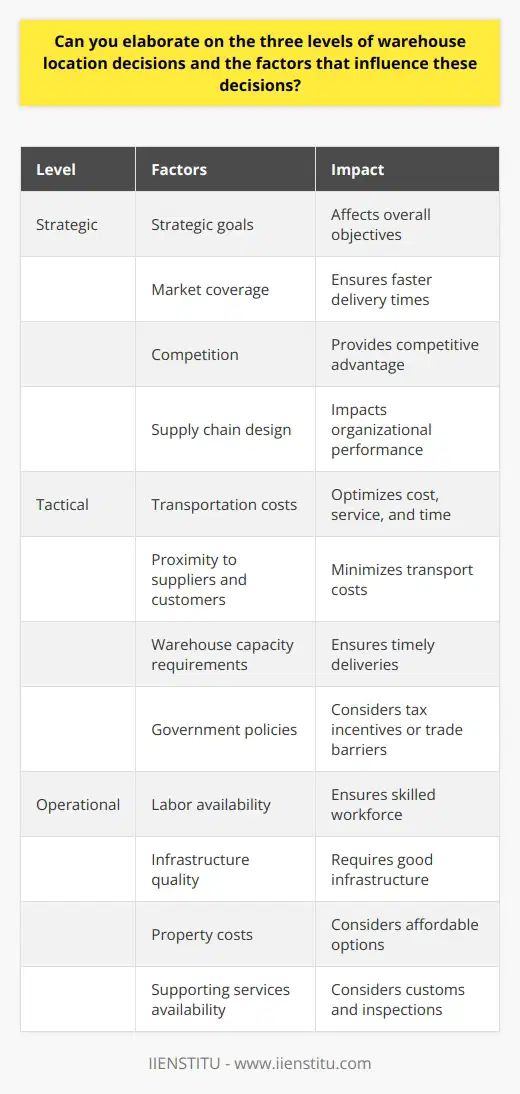
What are the key areas in warehouse management?
Subheadings: Inventory Control, Technology Integration, Order Processing, Space and Workforce Optimization, Safety Measures
To successfully oversee warehouse operations, one vital component is the implementation of effective inventory control procedures. Establishing a stock control system helps in tracking the storage, movement, and accessibility of goods while minimizing errors and waste. Proper inventory control can also maximize warehouse space usage and avoid overstocking or stock-outs.
Incorporating technology contributes significantly to efficient warehouse management. Deploying warehouse management systems (WMS) facilitates real-time inventory tracking, data analysis, and decision-making. Furthermore, the integration of barcoding and radio frequency identification (RFID) systems promotes accuracy in handling goods, leading to reduced operational costs.
Efficient order processing is another key area to consider. A well-organized order picking and packing process helps in fulfilling customer requests in a timely manner. Streamlining this process reduces order cycle times and increases customer satisfaction. Moreover, implementing mechanisms for handling returns, exchanges, and reverse logistics ensures smooth operations and positive customer experiences.
Optimizing space and workforce utilization is crucial for warehouse productivity. Space optimization involves layout planning, storage equipment selection, and adherence to various product requirements. Adequate workforce management includes staff training and performance evaluations, promoting a skilled and versatile workforce that can adapt to evolving market conditions.
Lastly, upholding safety measures within the warehouse is paramount. Enforcing safety policies and procedures, conducting regular inspections, and addressing potential hazards creates a secure working environment. Prioritizing safety not only prevents accidents and injuries but also contributes to overall operational efficiency.
In conclusion, the key areas in warehouse management encompass inventory control, technology integration, order processing, space and workforce optimization, and safety measures. Addressing these areas allows businesses to streamline operations, reduce costs, and meet customer demands, ultimately ensuring a competitive advantage in today's complex market.
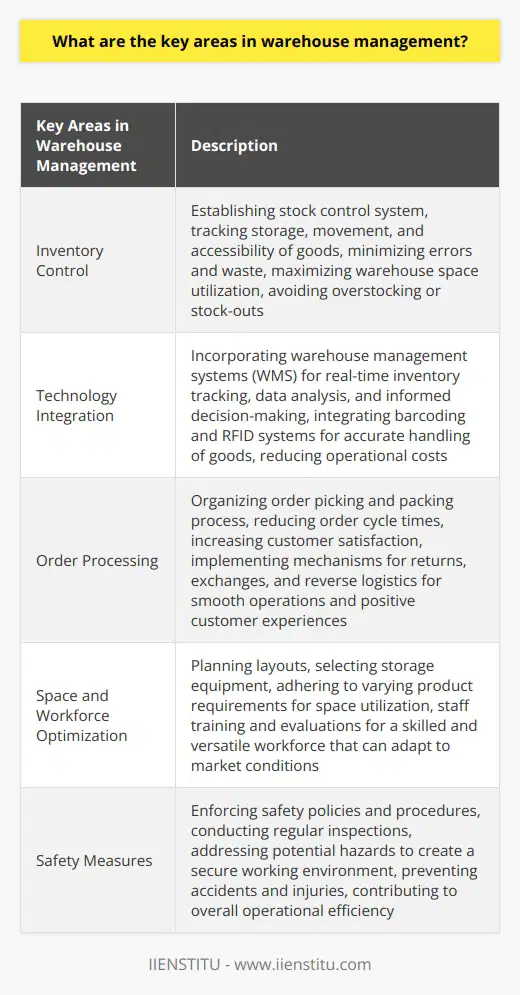
What are the factors considered in deciding on the location and layout of a warehouse?
**Factors in Warehouse Location**
The location of a warehouse is crucial, as it significantly affects the supply chain efficiency. Firstly, proximity to major transportation routes facilitates easy access to and from the warehouse. Secondly, the warehouse should be near suppliers, reducing the lead time for receiving goods. Lastly, the geographical location should be near the customer base, promoting customer satisfaction and decreasing transportation costs.
**Warehouse Layout Considerations**
Several factors must be considered when designing a warehouse layout. To optimize storage capacity and movement efficiency, organizations need to assess the space available and align it with their inventory requirements. A smooth flow of goods can be ensured through the proper organization of storage racks, by designating appropriate areas for different categories of products, such as fast-moving items, perishables, or hazardous materials.
**Material Handling Equipment Requirements**
A warehouse must include the necessary material handling equipment such as forklifts, pallet-jacks, and conveyors to facilitate the efficient movement of goods. The chosen equipment should be compatible with the warehouse layout and suit the specific needs of the organization, like lifting capacities, the size of products, and the required level of automation.
**Storage and Picking Methods**
The storage and picking methods employed in a warehouse are paramount for productivity. Companies can choose from various storage systems such as single-deep pallet racking, double-deep pallet racking, or drive-in pallet racking, depending on their inventory type, product accessibility requirements, and available space. The picking methods should enable warehouse staff to access goods easily and quickly, reducing the time and labor required for order fulfillment.
**Safety Protocol and Compliance**
A warehouse should comply with safety regulations and guidelines to prevent accidents and potential liabilities. This includes proper safety equipment, fire protection systems, and adequate lighting to ensure staff and the stored products are well protected. Additionally, a warehouse that handles perishable or hazardous materials should adhere to appropriate safety and hygiene standards.
In conclusion, the location and layout of a warehouse are of utmost importance for ensuring efficient supply chain operations. Key factors that must be considered include transportation access, proximity to suppliers and customers, warehouse layout design, material handling equipment, storage and picking methods, and safety and compliance standards. A well-thought-out warehouse location and layout decision can significantly enhance business performance and customer satisfaction.
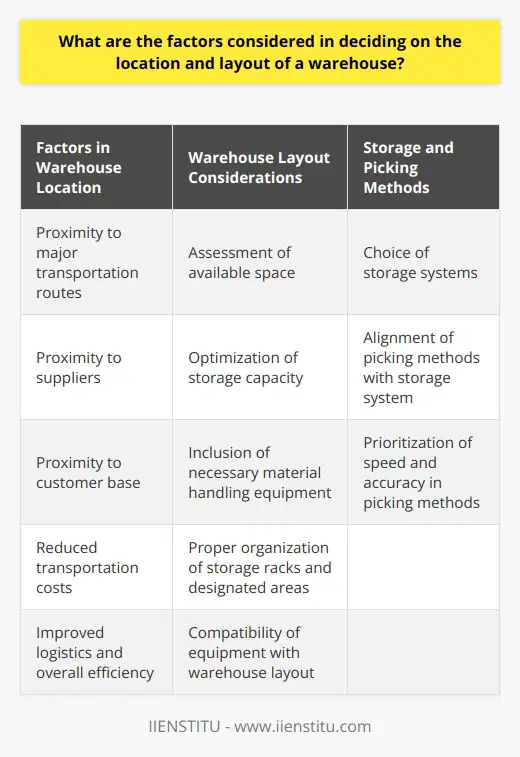
What are the 3 keys parts of warehousing logistics?
**Effective Storage Management**
One of the three key parts of warehousing logistics is effective storage management. This element involves optimizing the available storage space to accommodate various types of products while maintaining a well-organized and safe environment for goods and personnel. Efficiency in storing products directly affects the warehouse's accessibility and ease of operations, contributing to the overall success of logistics.
**Streamlined Inventory Control**
Another crucial component is streamlined inventory control, which encompasses the process of tracking, managing, and replenishing inventory levels. Accurate inventory management ensures the availability of the right stock at the appropriate time, preventing stockouts and overstocking. Moreover, effective inventory control allows companies to make informed decisions on order fulfilment, reducing the risk of order cancellations or delays, which can significantly impact customer satisfaction and overall business performance.
**Seamless Material Handling**
Lastly, seamless material handling forms an essential aspect of warehousing logistics. This part refers to the processes involved in the efficient movement of goods within and outside the warehouse, which includes receiving, picking, packing, and shipping activities. Utilizing appropriate material handling equipment, technology, and techniques minimizes product damage, reduces labor costs, and increases the overall efficiency of the warehouse, ultimately enhancing an organization's competitiveness in the market.

What are the five major decision areas of supply chain management?
**Introduction to Supply Chain Management Decision Areas**
Supply chain management is a multifaceted field that involves diverse entities collaborating to efficiently manage the flow of goods, services, and information from the point of origin to their final destination. In order to operate effectively, there are five significant decision areas that managers must address to ensure a seamless, functional, and profitable supply chain.
**Strategic Decisions: Long-term Planning**
The first area involves strategic decisions, which are related to long-term planning. These decisions set the foundation for the supply chain, and may include selecting suppliers, determining inventory policies, designing distribution networks, and formulating a transportation strategy. Strategic decisions affect the overall direction of the supply chain and have a lasting impact on its performance.
**Tactical Decisions: Short-term Operational Goals**
The next critical area is tactical decision-making, which is concerned with addressing short-term operational goals. Tactical decisions often revolve around demand forecasting, production scheduling, and inventory control. The objective of these decisions is to maintain adequate stock levels, optimize resource allocation, and minimize operational costs, while meeting customer requirements on time and in full.
**Sourcing Decisions: Procurement and Vendor Management**
Sourcing decisions are crucial in supply chain management, as they determine the procurement processes and vendor partnerships needed to obtain raw materials, components, or finished goods. Key components of this decision area include supplier selection, contract negotiation, vendor performance assessment, and risk management. Effective sourcing decisions lead to a more resilient supply chain, maximizing efficiency and minimizing disruptions.
**Operational Decisions: Production, Distribution, and Logistics**
Operational decisions focus on the production, distribution, and logistics processes that ensure goods and services are delivered to customers efficiently and effectively. This entails managing product flow, warehousing, transportation, and overall network optimization. These decisions require real-time data and continuous coordination among stakeholders, enabling organizations to respond rapidly to changing customer needs and market conditions.
**Reverse Logistics Decisions: Sustainability and Waste Management**
Finally, managerial decisions must also address reverse logistics, which involves the management of product returns, recycling, and waste disposal. These decisions aim to optimize the end-of-life phase of a product, focusing on minimizing environmental impacts and ensuring regulatory compliance. Sustainable supply chain practices, such as reducing waste and embracing circular economy principles, are becoming increasingly important in modern business operations.
In summary, effective supply chain management hinges on the ability to make informed decisions across these five critical areas: strategic, tactical, sourcing, operational, and reverse logistics. Balancing the objectives of each area while maintaining a holistic view of the supply chain ecosystem is an essential skill for managers in this domain, as they work to optimize overall performance and customer satisfaction.
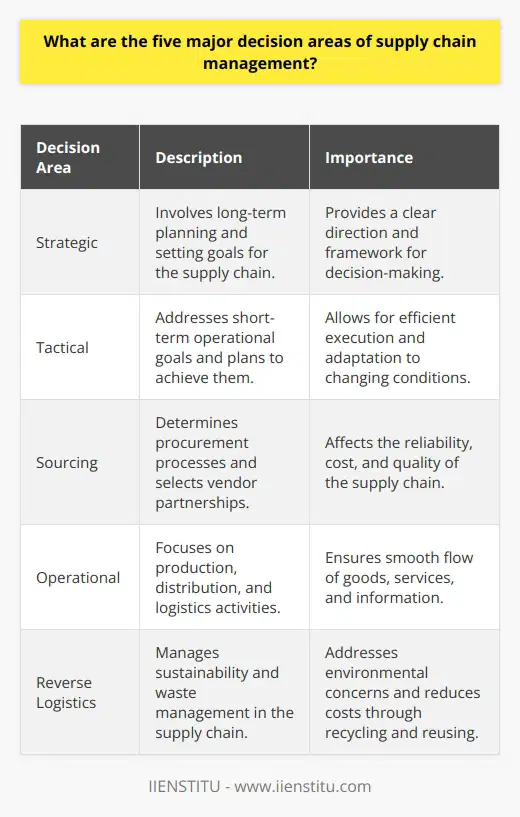
What are the three key factors that may influence making any decision regarding warehousing?
Considering Warehousing Factors
Location Analysis
One of the most fundamental elements in warehouse decision-making is the location factor. Choosing an optimal location for a warehouse significantly affects transportation costs, lead times, and overall supply chain efficiency. A carefully selected location is directly connected to the level of accessibility, transport infrastructure, and proximity to suppliers and customers. Therefore, a comprehensive location analysis must be conducted to ensure that the chosen site meets the company's logistical requirements while maximizing cost savings and supply chain efficiency.
Operational Costs
Another critical aspect of warehousing decisions is the assessment of the operational costs, which can considerably impact the profitability of a company. These expenses consist of the construction or rental costs, labor and energy expenses, as well as the ongoing maintenance and security expenditures. It is crucial for companies to carefully analyze these operational costs to achieve an efficient warehousing strategy. Moreover, decision-makers should seek to balance short-term requirements with long-term growth perspectives, ensuring that the warehousing approach remains adaptable to changing business needs.
Technological Integration
Lastly, the level of technological integration is a vital factor influencing the warehousing decision-making process. Modern warehousing systems require the implementation of advanced technologies, such as warehouse management software, robotic automation, and data analytics tools. The successful integration of these cutting-edge solutions not only enhances warehouse performance but also increases the overall supply chain visibility and control. To best leverage these technological advancements, companies should thoroughly assess their current and future needs in terms of data management, automation, and process optimization. Deciding on the type and extent of technological solutions to adopt is crucial in defining a warehousing strategy that effectively supports and drives the organization's growth.
In conclusion, the location, operational costs, and technological integration are the three key factors that underpin any decision-making process regarding warehousing. A well-rounded analysis of these factors allows companies to optimize their warehousing strategies, reducing logistical expenses, and enhancing supply chain performance. Furthermore, informed decisions in warehouse management foster overall business growth and resilience, ensuring long-term success in today's rapidly-changing economic landscape.
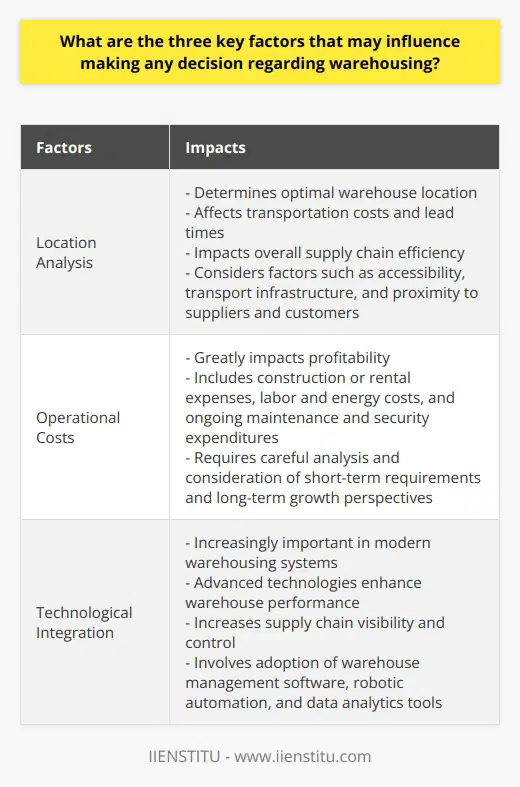
How do warehouse location and layout decisions impact overall operational efficiency and cost-effectiveness within a supply chain?
Warehouse Location Factors
Selecting a warehouse location can significantly impact the supply chain's operational efficiency and cost-effectiveness. Proximity to transportation networks, customers, and suppliers influences transport costs and delivery times. When warehouses are placed closer to these key nodes, companies can reduce transportation expenses and expedite delivery processes, resulting in increased cost savings and customer satisfaction. Furthermore, selecting locations with lower labor, utility, and real estate costs can contribute to better financial performance.
Warehouse Layout Considerations
Optimizing the layout of a warehouse is crucial for improving operational efficiency. A well-designed layout enables smooth material flow, reduces handling efforts, and minimizes process bottlenecks. Implementing an effective slotting strategy, aligning warehouse resources such as storage, picking, packing, and loading areas, and adopting technologies like automated storage and retrieval systems (AS/RS) can greatly enhance the warehouse's overall productivity.
Storage Space Utilization
Efficient use of available storage space is essential for cost-effective warehouse operations. By implementing effective storage solutions, such as adjustable racking systems and warehouse management software, companies can maximize the available space and optimize product storage. By increasing storage density and reducing unnecessary space, businesses can keep inventory holding costs down and increase warehouse capacity, thereby enhancing the warehouse's overall cost-effectiveness.
Process Integration
Warehouse operations should be closely integrated with other logistical processes in the supply chain. By maintaining effective communication between procurement, warehouse, transportation, and demand planning teams, companies can minimize delays, improve order accuracy, and better match supply to demand. This functional integration ultimately results in lower operational costs and higher overall efficiency.
In conclusion, warehouse location and layout decisions play a pivotal role in determining the overall operational efficiency and cost-effectiveness of a supply chain. By making strategic choices regarding location factors, warehouse layouts, storage space utilization, and process integration, companies can maximize the performance of their warehouse operations and enhance the overall competitiveness of their supply chains.
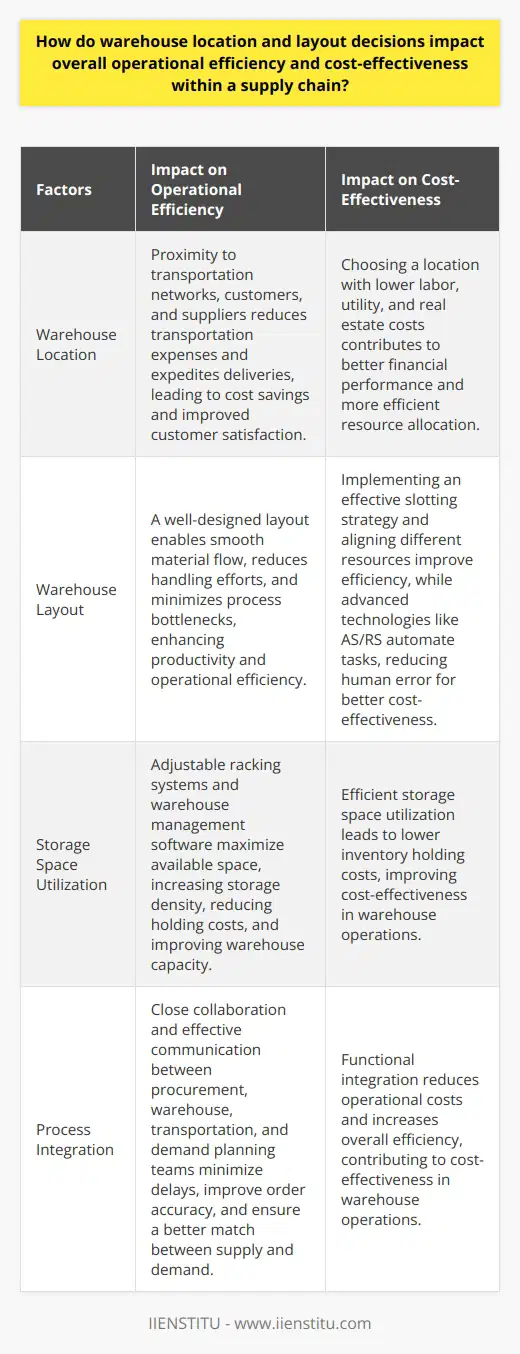
What are the factors to consider while choosing a warehouse location?
Accessibility and Transportation
Firstly, one paramount factor when selecting a warehouse location is accessibility and transportation. The site should be easily reachable and well-connected to major highways, airports, and ports.
Proximity to Market
Secondly, proximity to key markets also plays a significant role. It can reduce transportation costs and lead time, giving your company a competitive edge.
Infrastructure
Furthermore, the existing infrastructure at the location is crucial to consider. This includes the condition of roads, availability of utilities, and the size and layout of the warehouse itself.
Workforce Availability
Another critical factor is the availability of workforce. A location with sufficient supply of skilled employees can reduce labor costs and increase productivity.
Zoning and Regulations
Consider zoning regulations and ensure the selected area is zoned for warehouse operations. Compliance with social, economic, and environmental regulations is also important.
Climate
The traits of the local climate can impact warehouse operations, affecting the selection process. Extreme weather conditions may disrupt transportation and require additional storage safeguards.
Future Expansion Possibility
Lastly, consider future expansion opportunities. If the business is expected to grow, the storage needs may increase and the warehouse location should be able to accommodate this.
In conclusion, the choice of a warehouse location goes beyond just a physical site. It is an intricate process that needs a thorough understanding of various factors such as accessibility, market proximity, infrastructure, labor availability, regulatory compliance, local climate, and potential for expansion.
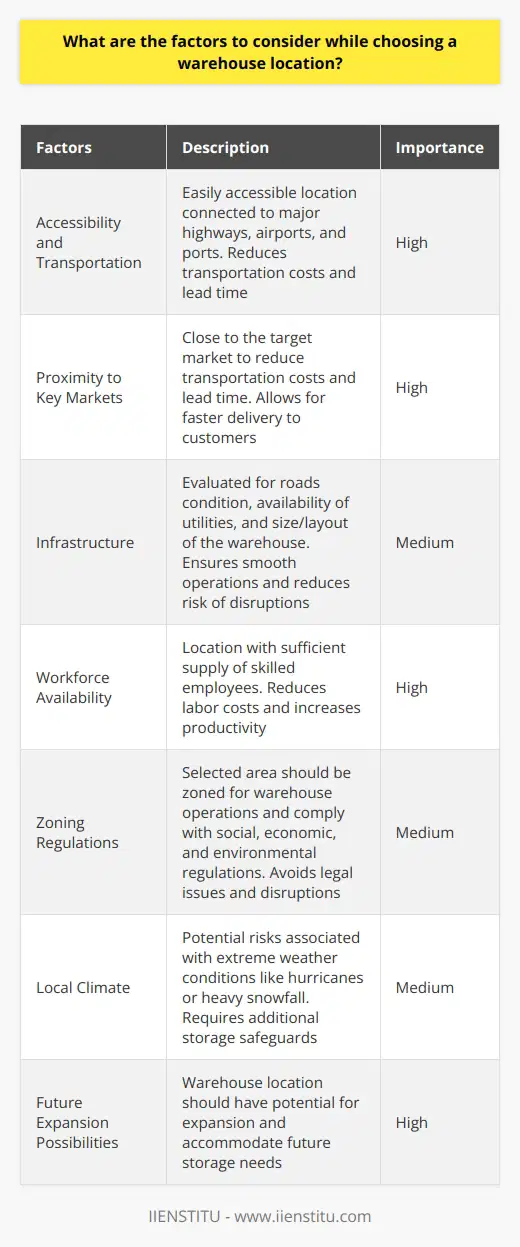
What determines the size of warehouse and layout?
Warehouse Size Determinants
The size of a warehouse primarily depends on the volume of goods that an organization intends to store. A larger volume of goods translates to a larger warehouse size. The type of goods also comes into play. For instance, larger, heavyweight goods demand more spaces compared to smaller, lightweight items. Therefore, one must consider the volume and type of goods before deciding on warehouse size.
Warehouse Layout Factors
Another aspect that business owners need to consider is the warehouse layout. The flow of goods within a warehouse determines its layout. If the goods need to be moved frequently, a layout that allows easy movement becomes necessary. Efficiency in inventory management is also a key determinant of warehouse layout. A well-planned layout ensures sped up operations, resulting in higher productivity.
Furthermore, the type of technology used for goods handling can affect the warehouse layout. For example, if the organization uses automated systems for goods storing and retrieval, the layout should accommodate these technologies.
Safety Considerations
Lastly, safety is a crucial determinant of both warehouse size and layout. A warehouse should have enough space to allow safe movement of both goods and personnel. It should also follow local building codes and regulations. All these considerations about size, layout, type of goods, technology used and safety measures contribute to the optimized functioning of a warehouse.
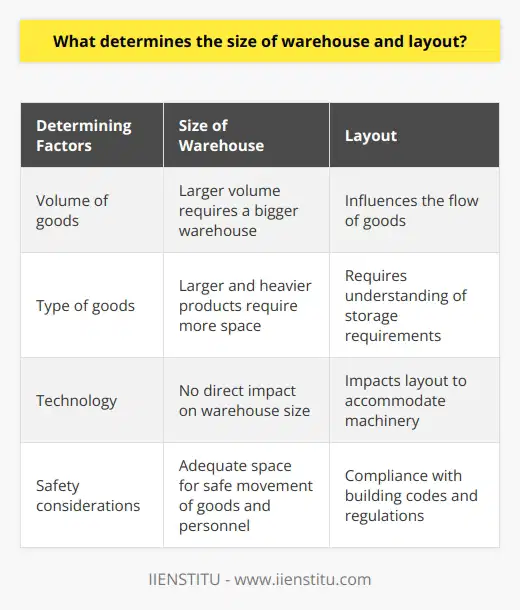
What are the four decision areas in supply chain management?
Decision Areas in Supply Chain Management
Supply Chain Strategy
Determining the supply chain strategy involves aligning the chain's long-term plans with the goals of the organization. It involves mapping out supplier relationships, logistics, inventory strategies, and overall management.
Supply Chain Network Design
This decision area looks into the optimization of the structure of the supply chain. It scrutinizes the chain’s physical layout, its facilities, the transportation modes employed, and the interconnections between facilities.
Supply Chain Operations
Supply chain operations entail the day-to-day management of the supply chain. Decisions revolve around effective and efficient operations, demand forecasting, production scheduling, inventory management, and order delivery.
Supply Chain Integration and Strategic Alliances
Enhancing supply chain performance often requires an integrated view, bringing together buyers, suppliers, and other stakeholders. It also entails strategic alliances, which are collaborative efforts to enhance overall supply chain efficiency.
In conclusion, the four decision areas in supply chain management: supply chain strategy, supply chain network design, supply chain operations, and supply chain integration and strategic alliances, play a significant role in the success of every organization’s operations. Understanding these areas enables the organization to make informed decisions, thereby improving efficiency and effectiveness throughout the supply chain.
